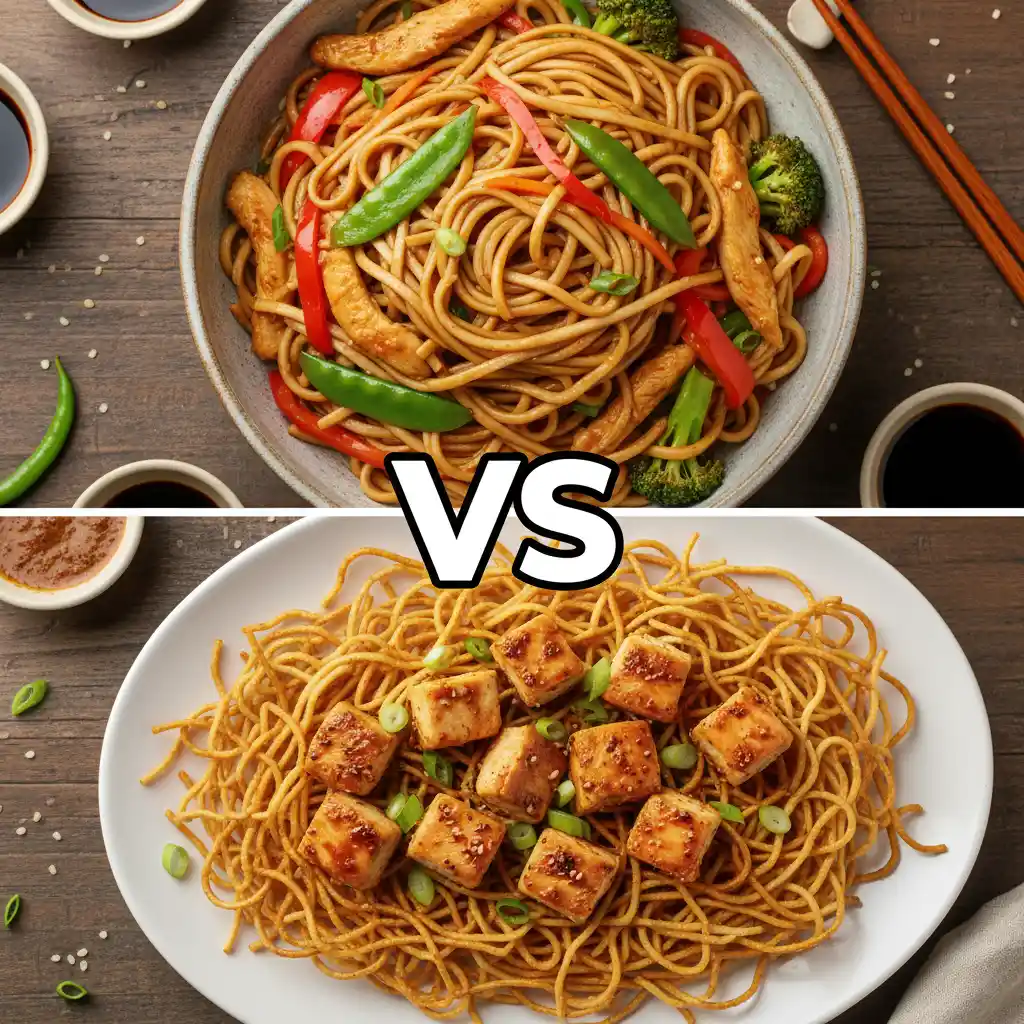
There’s something about Chinese takeout nights that always brings comfort, especially when the debate of chow mein vs lo mein comes up. Both dishes feature delicious noodles, a savory sauce, and loads of flavor—but they’re not the same. If you’ve ever wondered which is healthier, tastier, or easier to cook at home, this guide is for you. We’ll break down everything from noodle texture to cooking methods, and share which dish might suit your taste buds better. Let’s get into the flavors, the fun, and the facts about these two beloved noodle dishes.
Table of Contents
Table of Contents
When comfort food meets crispy or chewy noodles
The first time I tasted lo mein, I was a kid sitting at my grandmother’s tiny kitchen table. She used store-bought egg noodles, a splash of soy sauce, and whatever vegetables she had in the fridge. It was simple and soft, and every bite felt like a warm hug. A few years later, I tried chow mein at a bustling street market, and the crispy texture was such a surprise—it crackled and popped, unlike anything I’d ever had.
Since then, the chow mein vs lo mein debate has lived rent-free in my head (and my kitchen). They both have their place. Lo mein is smooth, slightly chewy, and often soaked in sauce. Chow mein, on the other hand, gives you that golden, pan-fried crunch that pairs so well with stir-fried veggies or chicken. It’s not just about preference—it’s about the story the dish tells on your plate.
Sometimes I want the bold crunch of chow mein after a long day, and other times I crave the silkiness of lo mein when I’m feeling nostalgic. But whether it’s for a weeknight dinner or a lazy Sunday lunch, chow mein vs lo mein always sparks curiosity, and often a second helping.
If you enjoy savory Asian-style dishes, you might also love the miso soup made simple or try your hand at a veggie-packed wok stir fry with frozen vegetables and water chestnuts—both great sides to any noodle meal.
Understanding what defines each noodle dish
To truly appreciate the difference in chow mein vs lo mein, we need to start with the basics: how they’re made. Lo mein translates to “tossed noodles” in Cantonese. These noodles are fully cooked before being mixed with sauce, protein, and vegetables. There’s no frying involved. The result? A soft, glossy dish where the noodles soak up every drop of flavor.
Chow mein, on the flip side, means “fried noodles.” The noodles are either deep-fried until crunchy or pan-fried for a crisp edge. You’ll still find sauce and vegetables, but the noodles keep their texture, standing up to bold stir-fry techniques.
Both dishes use Chinese egg noodles, but the preparation makes all the difference. And that’s where personal taste comes in—some crave that chewy texture, others love the sizzle of fried strands. For something more unique, give vegetable egg foo young a try—it’s another dish where textures take center stage.
How They Feel & Fuel You
Texture that makes or breaks the bite
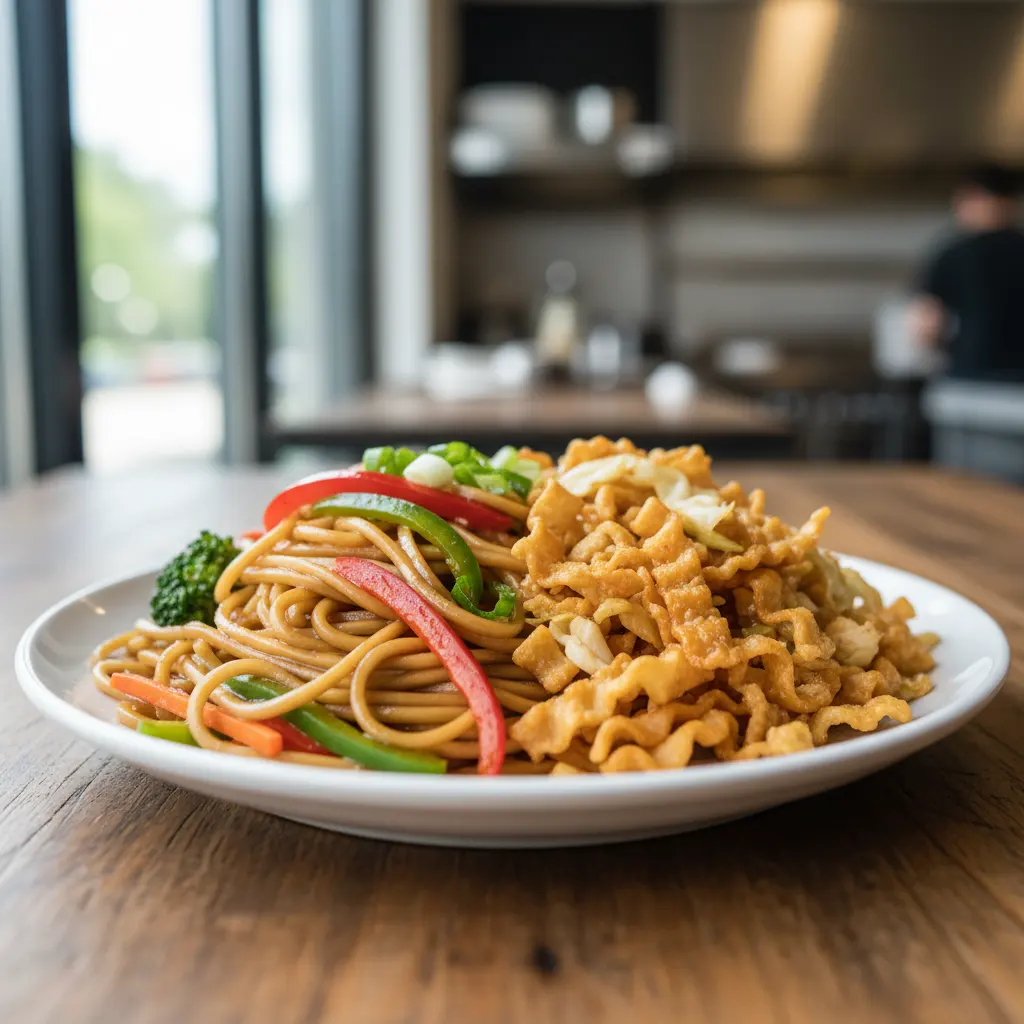
The biggest standout in the chow mein vs lo mein conversation? Texture. Chow mein brings the crisp. The noodles are either pan-fried or deep-fried, creating golden edges that hold their shape even under rich sauce. Every bite has a bit of crunch, making chow mein feel more like a stir-fry with attitude.
Lo mein, though, is the definition of comfort. The noodles are fully boiled, then tossed with sauce, veggies, and proteins. They’re smooth, slurpable, and tender. Lo mein soaks up sauce like a sponge, which means every bite bursts with flavor.
If you’re in the mood for something crispy, chow mein gives you that edge. But if you want something that feels like a savory noodle soup without the broth, lo mein is your go-to. You might even enjoy pairing it with sides like campfire shrimp skillet or a lighter option like blackstone tortellini for a balanced meal.
Nutrition: Is lo mein healthier than chow mein?
This question comes up a lot, and the answer isn’t black and white. When it comes to chow mein vs lo mein, the cooking method changes everything.
Chow mein is typically fried. That means more oil, more calories, and often more sodium—especially in restaurant versions. If you’re watching your fat intake, chow mein might not be the best everyday choice.
Lo mein is boiled, not fried, so it tends to be lower in fat. But don’t assume it’s always “healthy.” Lo mein can still be heavy on sauce, which can add sugar and sodium. The healthiest versions of either dish are the ones made at home, where you control the oil, ingredients, and seasonings.
Here’s a quick comparison of key nutrition points for a standard 1-cup serving of each dish:
Calories: Chow mein ranges from 280 to 400 calories per cup, depending on how much oil is used. Lo mein is generally lighter, coming in at around 200 to 300 calories.
Fat: Chow mein typically contains 10 to 20 grams of fat due to the frying process. Lo mein uses less oil and usually falls between 5 and 12 grams of fat.
Protein: Both dishes are fairly similar in protein, with chow mein offering 8 to 15 grams and lo mein providing roughly 8 to 14 grams per serving.
Cooking Style & Substitution Talk
How they’re made in the kitchen
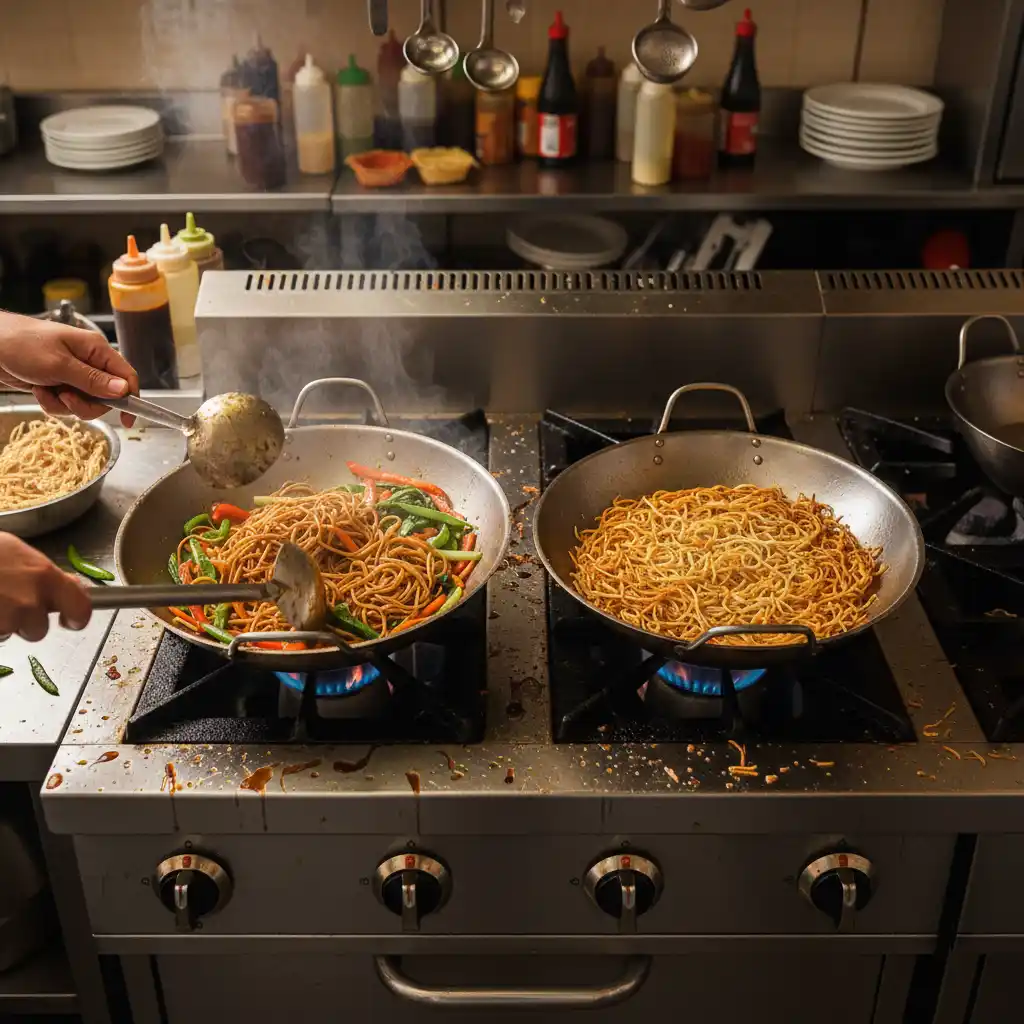
The cooking method is what truly defines the chow mein vs lo mein difference. While both start with Chinese egg noodles, they take very different paths in the pan.
Chow mein noodles are either parboiled or soaked briefly and then fried until they’re crispy and golden. You might see them pan-fried in a thin layer, forming a crunchy bed for vegetables and meat. Other times, especially in American Chinese restaurants, they’re deep-fried into crunchy nests. This approach gives chow mein its signature texture and makes it ideal for saucy toppings that don’t turn the noodles soggy.
Lo mein, on the other hand, skips the fry. The noodles are fully boiled until tender, then tossed directly into a wok or skillet with sauce and stir-fried veggies. It’s more about the toss than the sizzle. The result is a glossy, slurp-worthy noodle dish that feels more like pasta than crisp stir-fry.
Dishes like San Giorgio lasagna follow a similar principle—cooked noodles layered or tossed in sauce rather than crisped. The cooking method here speaks to preference: do you want crispy edges or silky strands?
Why Americans mix them up (and how to tell the difference)
If you’ve ever ordered “lo mein” and received something crunchy, you’re not alone. In many American takeout menus, chow mein vs lo mein becomes a labeling game. Sometimes the names are used interchangeably. Other times, chow mein is used as a blanket term for any stir-fried noodles, regardless of cooking style.
This confusion likely started with regional differences in Chinese-American cuisine. On the East Coast, lo mein typically refers to soft noodles tossed with sauce. On the West Coast, ordering chow mein might get you soft noodles too, unless you ask for “Hong Kong style,” which guarantees crispy.
Here’s a quick tip:
- If the noodles are soft and saucy, it’s lo mein.
- If they’re crisp or even crunchy, you’ve got chow mein.
Want to avoid the mix-up? Make your own at home and skip the takeout guessing game. Pair either with a side of San Giorgio noodles lasagna for a noodle-packed night, or explore textures in dishes like miso soup that bring balance to a meal.
FAQ
Which is better, chow mein or lo mein?
That depends on what you’re craving. Chow mein is ideal if you want something crispy with a bit of bite. It pairs beautifully with stir-fried veggies or saucy proteins that need a solid noodle base. Lo mein is perfect when you’re in the mood for soft, sauce-coated noodles that feel comforting and warm.
If you’re making dinner at home and want something that holds sauce like a champ, lo mein might be your pick. For a bold dish that offers contrast in texture, go with chow mein. Both are flavorful—just different kinds of satisfying.
Looking to build a full meal around either dish? You might love this wok stir fry with frozen vegetables and water chestnuts or even a protein-packed blackstone tortellini as a fun fusion option.
Is lo mein healthier than chow mein?
In many cases, yes. Because lo mein noodles are boiled, not fried, they tend to be lower in fat and calories. Chow mein’s frying step often adds extra oil and sodium, especially in takeout versions. But keep in mind, it also depends on what else is in the dish—sauce, meat, and veggies can all shift the nutrition balance.
If you’re looking for a lighter option, homemade lo mein with lean proteins and veggies is a great choice. Chow mein can still be part of a balanced diet if prepared with care.
Why do Americans call chow mein lo mein?
The chow mein vs lo mein mix-up in the U.S. is mostly a result of regional terminology. Some restaurants label both dishes as “chow mein” regardless of how they’re cooked. In other cases, “lo mein” is used for any soft noodle dish.
The inconsistency started decades ago when Chinese-American cuisine was adapting to local tastes. Today, unless you’re ordering from a place that specifies cooking style (like “Hong Kong-style chow mein”), it’s not always clear what you’ll get
Can chow mein noodles be substituted for lo mein noodles?
Yes—but with a twist. You can use the same kind of egg noodles for both dishes, but how you prepare them matters. If you’re making lo mein, boil the noodles and toss them with sauce. For chow mein, you’ll want to pan-fry or crisp them up to get that signature texture.
Substituting the noodles is easy if you adjust your cooking method. Just don’t expect a crunchy chow mein experience if you skip the frying step.
You can test both approaches with a base noodle like those in San Giorgio noodles lasagna or explore other textures through recipes like vegetable egg foo young.
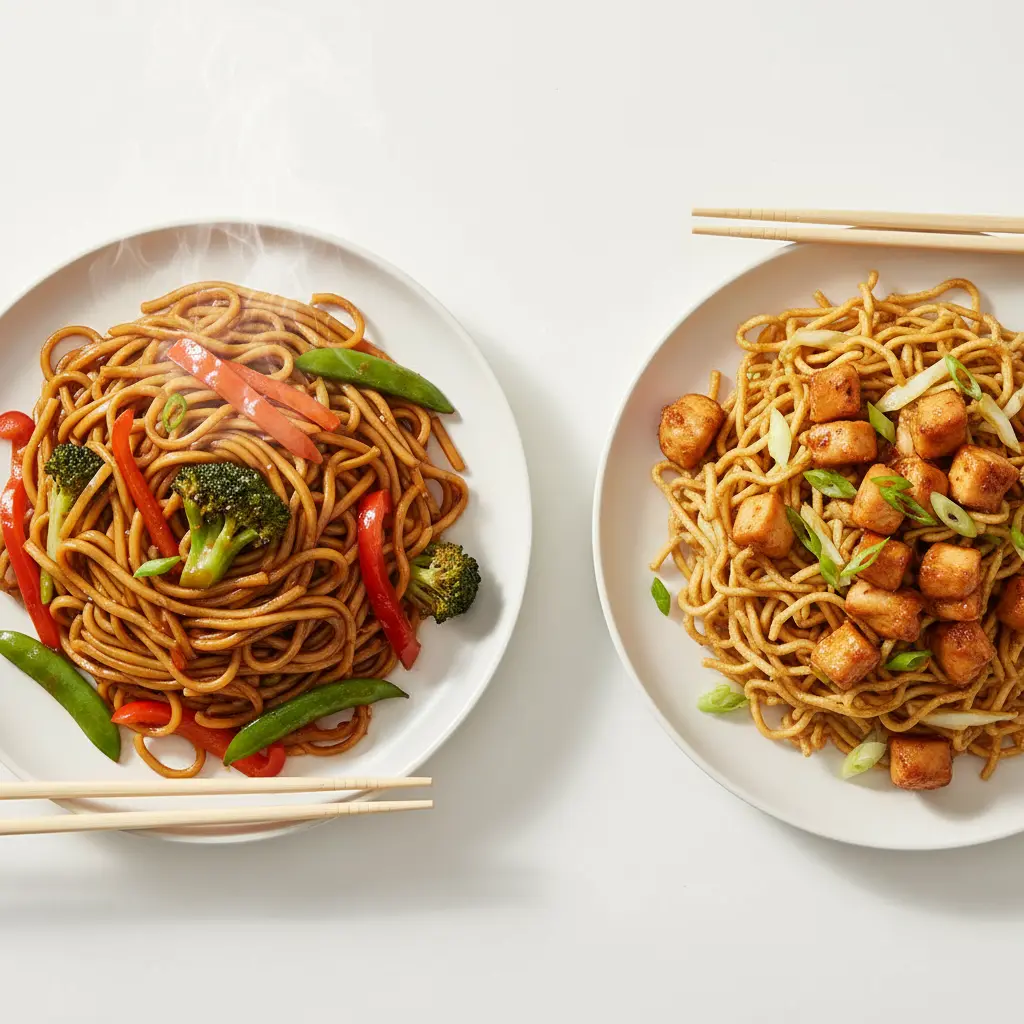
Conclusion
In the end, chow mein vs lo mein isn’t a rivalry—it’s a choice between two flavorful traditions. Chow mein gives you that crispy edge and stir-fried boldness. Lo mein brings comfort and richness in every saucy bite. Both dishes tell their own story with the same core ingredients, just told two very different ways.
Whether you’re ordering in or cooking at home, understanding the differences helps you get exactly what you’re hungry for. And next time someone asks you which one’s better, you’ll know the real answer: it depends on the day—and your craving.
Print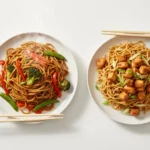
Chow Mein vs Lo Mein: Key Differences That Will Surprise You
- Total Time: 20 minutes
- Yield: 2 servings
Description
Classic chow mein vs lo mein – two takeout favorites made easy at home. Pick your texture: crispy or saucy.
Ingredients
8 oz Chinese egg noodles
2 tbsp soy sauce
1 tbsp oyster sauce
1 tsp sesame oil
2 cloves garlic, minced
1/2 cup shredded carrots
1/2 cup sliced bell peppers
1/4 cup scallions, chopped
1 tbsp vegetable oil
Instructions
1. Boil noodles until tender (for lo mein) or soak briefly (for chow mein)
2. In a wok, heat oil and sauté garlic
3. Add vegetables and stir-fry 2–3 minutes
4. Add noodles and toss
5. For chow mein, let noodles crisp in pan without stirring
6. Add sauces and stir to combine
7. Top with scallions and serve
Notes
Chow mein requires less liquid sauce to maintain crisp texture
Lo mein can use more sauce for a glossy finish
Use the same noodles, just change the technique
- Prep Time: 10 minutes
- Cook Time: 10 minutes
- Category: Main Course
- Method: Stir Fry
- Cuisine: Chinese-American
Nutrition
- Serving Size: 1 bowl
- Calories: 320
- Sugar: 5g
- Sodium: 800mg
- Fat: 12g
- Saturated Fat: 2g
- Unsaturated Fat: 9g
- Trans Fat: 0g
- Carbohydrates: 42g
- Fiber: 3g
- Protein: 10g
- Cholesterol: 45mg


